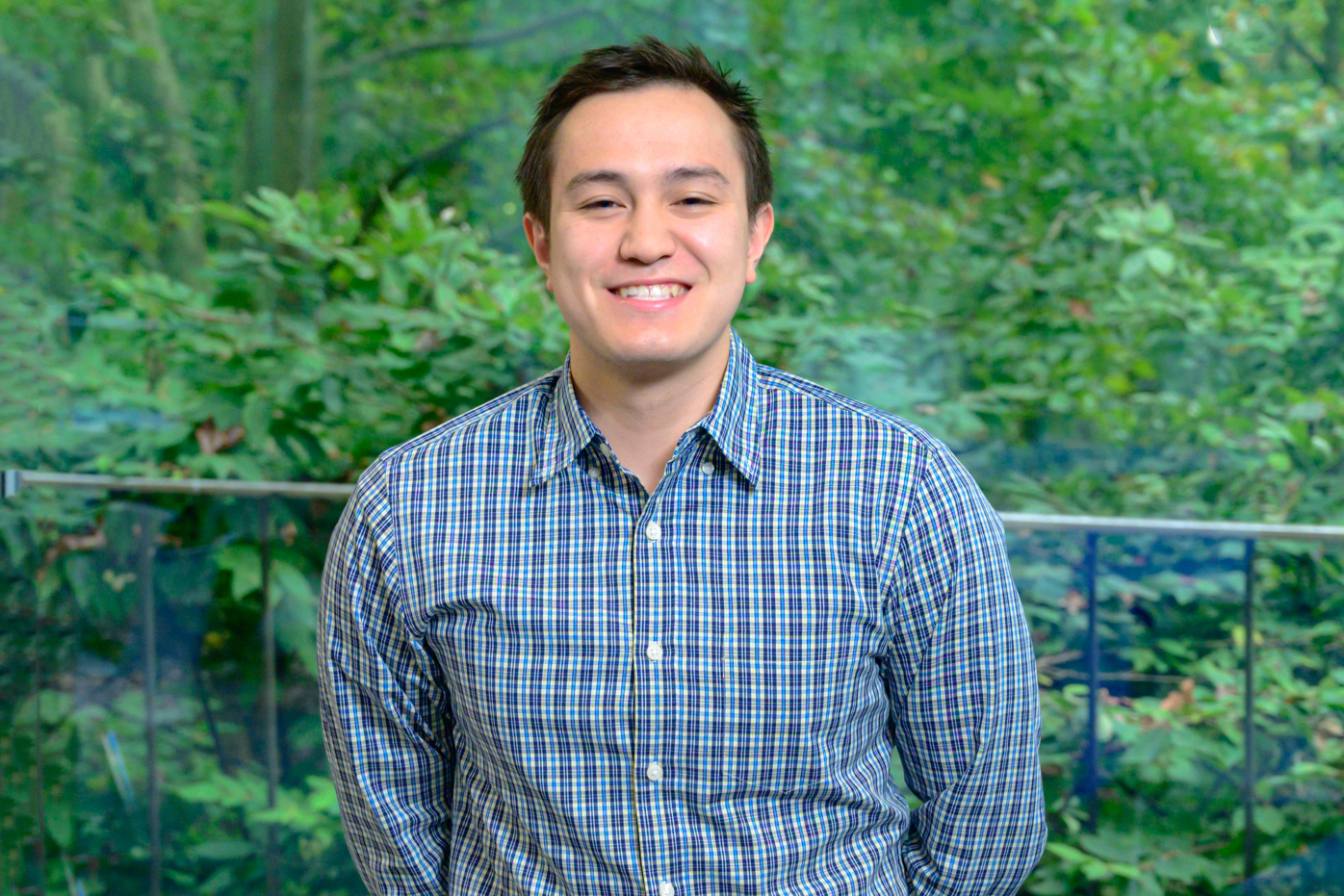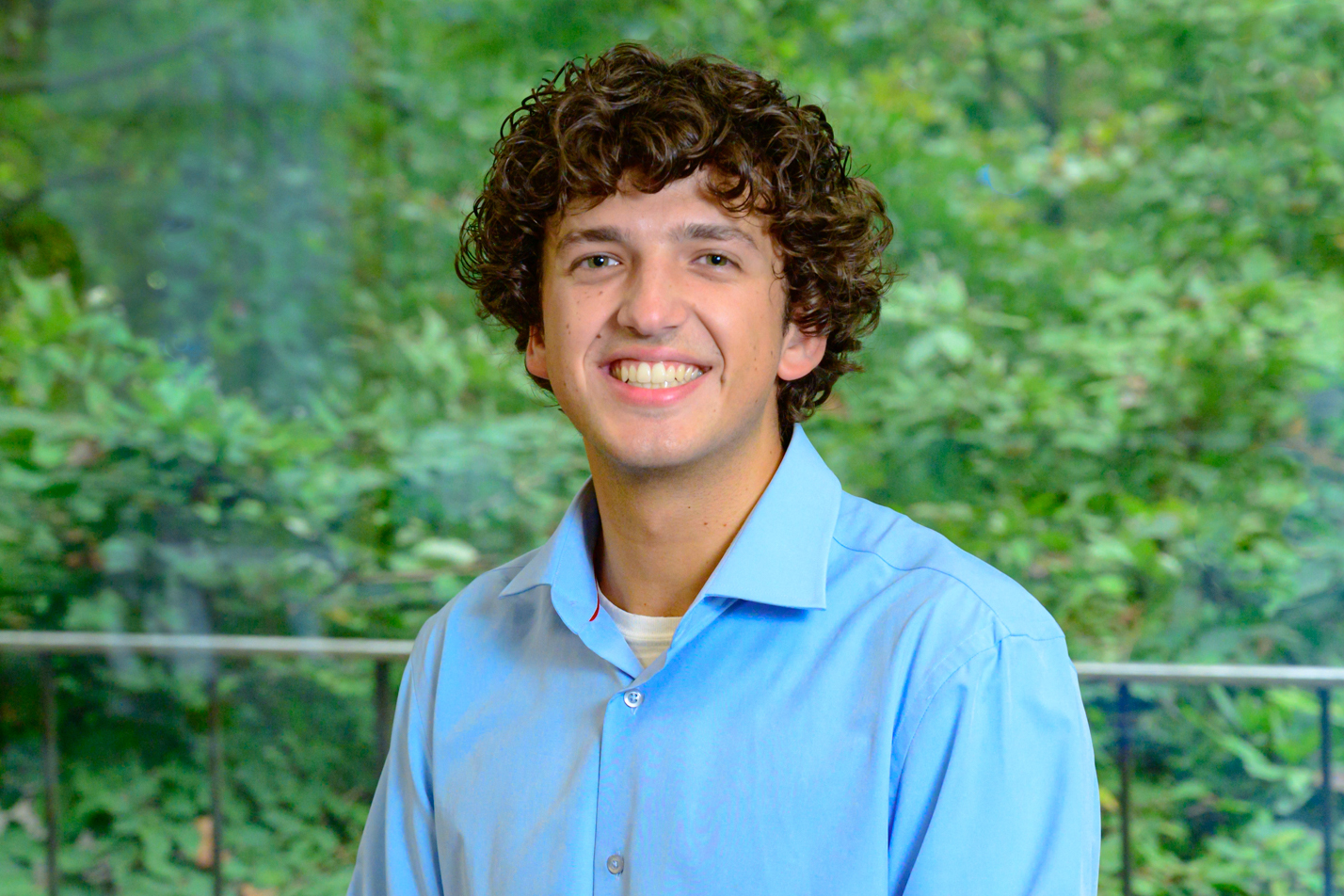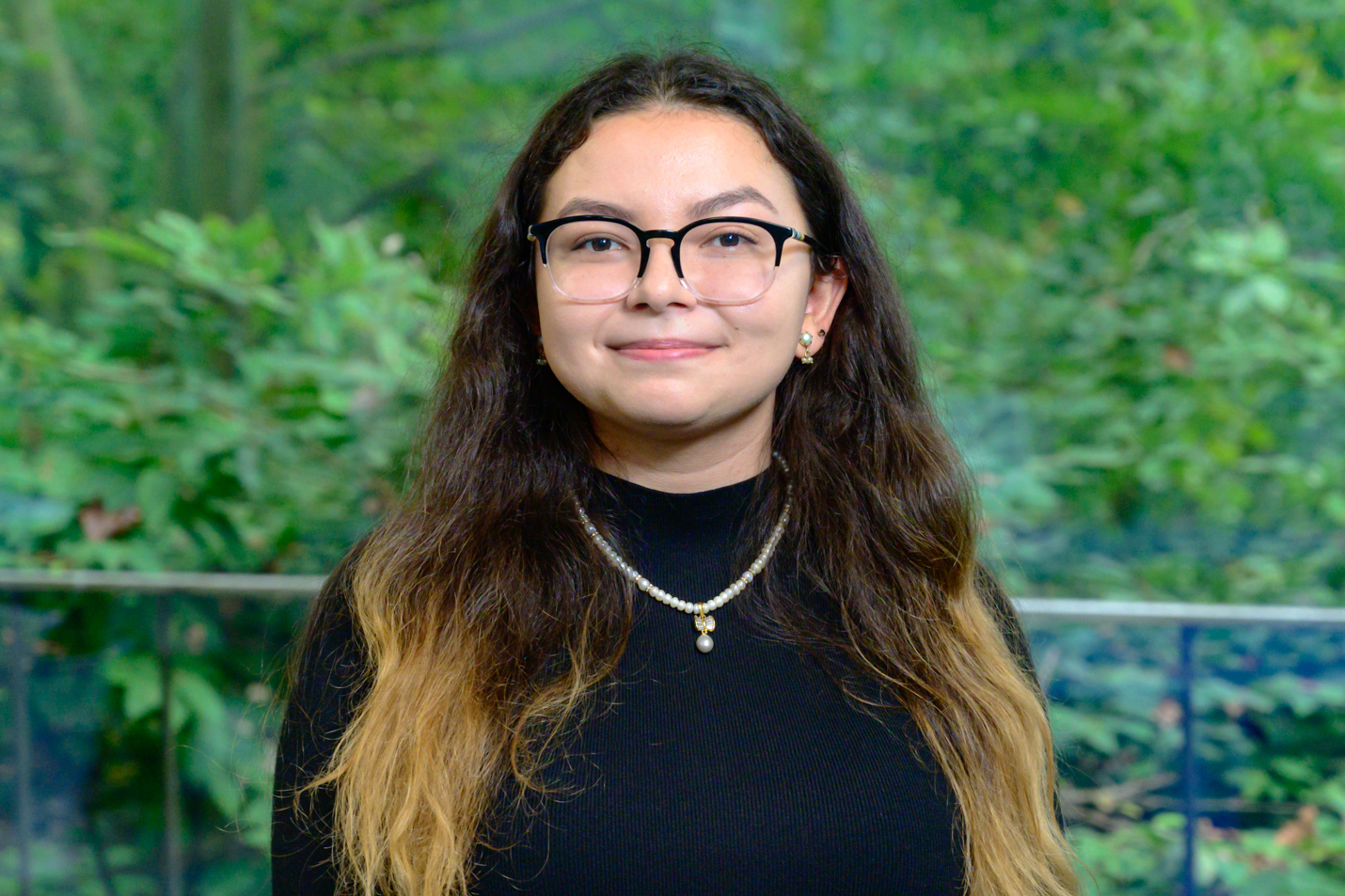Contact Us
Contact:
Jamie Wyatt
Director, Honors and Scholars Programs
Anderson Hall, Room 140 on a map
Summer Scholars and Artists Program 4400 Massachusetts Avenue NW Washington, DC 20016 United StatesDalia Abdo Kahin CAS, Neuroscience Faculty Mentor: Emily Grossnickle-Peter

Decision making is a pervasive and influential component of human behavior. Its biological processes are not fully understood and are currently being studied. In order to familiarize myself with the literature, I conducted a systematized review of articles pertaining to the neural processes underlying human decision making. The Web of Science database was searched for relevant articles using specific search parameters, and 20 were selected in total. Those papers revealed that neuropsychologists do not agree on a single definition of decision making, which creates inconsistencies in research methods. The papers concur that the frontal lobe seems to be implicated in assigning value judgements, and that subcortical structures seem to be implicated in analyzing prior learning experience to inform those value judgments.
Paula Akakpo, SIS, International Studies Faculty Mentor: Gina Lambright
Across the African diaspora, political elites have used traditional rhetoric, personal representation, and policy to display their allegiance to citizens. Leaders such as Mobutu Sese Seko, former President of Zaire, have instituted policies that recognized them as a traditional force, removing colonial and Western influences from the country and aspiring to return the country to its “authentic” roots and values. Gnassingbé Eyadema, former President of Togo similarly adopted a policy of authenticity during this period, which Africanized the names of cities and required citizens to abandon their western names. However, it is still not well understood when and how political elites employ these narratives, especially in modern times. Therefore, the purpose of this research is to analyze the discourses surrounding tradition and culture amongst Togolese Political Elites as a means of understanding the role of tradition in Togolese politics. This project utilizes discourse analysis to examine how the characterization of Togolese Presidents has been framed, by whom, and to what ends. By analyzing speeches and campaign materials from Togo’s National Library and by conducting interviews with Togolese citizens, this study advances the claim that traditional representations are a means to strengthen political elitism in Togo. This analysis offers clear terminology to describe the phenomenon while considering the complexities of African tradition and the impact of colonial history on these beliefs. Finally, this study implies that traditional representations are a legitimation strategy that Togolese political elites use and urges future researchers to consider these representations in other contexts and how they shape the identities of citizens.
Madeleine Bartin, CAS/SIS, International Studies and Physics Faculty Mentor: Maya Livio

In cross mapping the distribution of heat, shade, heat sensitivity, and bus stop design, this project connects hostile architecture with environmental justice. Hostile architecture is a practice that attempts to guide and restrict behavior through urban design. AU Honors research project, Hidden Hostility DC, documented over 70 instances of hostile architecture in an interactive map of DC, including examples of anti-sleeping benches, spiked curbs, and angled heating vents intended to prevent people from laying on top for warmth. Their mapping included “ghost amenities”, which are spaces with a stark lack of amenities, such as an open park with no benches. In this sense, ghost amenities are essential for understanding the importance of spatial justice– the distribution of resources across a city. Shade, specifically, is an ever-important resource to understand. The findings of this project suggest that shaded bus stops are disproportionately located in neighborhoods that are already cooler, shadier, and less sensitive to heat.
Lia Burchianti, CAS, Art History Faculty Mentor: Joanne Allen

By analyzing visual representations found in museums, churches, and archival sources, this project illuminates how Mary Magdalene’s abandonment of worldly possessions and commitment to penance were symbolized through the use of her own hair as clothing. These depictions refer to the story where, after following Jesus, she spent time in the wilderness as a hermit, praying for repentance for her past as a prostitute. The story of Mary Magdalene as a repentant prostitute, while not reported in the Bible, was solidified in the 4th century as a powerful tool used to control societal views on women and their behavior. This image of Mary Magdalene persisted in art, sermons, and popular culture, tying a woman’s value to repentance. While it elevated Mary Magdalene as a figure of devotion, it did so within a framework that used her story to regulate and shame women more broadly. This research investigates how the image of Mary Magdalene adorned with her own hair evolved during the Italian Renaissance and it examines its broader implications for understanding the historical marginalization of women in religious iconography and discourse. Through an interdisciplinary approach—drawing from art history, religious studies, and feminist scholarship—the research explores the complex portrayal of Mary Magdalene as a figure who embodies intersections of gender, spirituality, and artistic representation. The project combines scholarly analysis with visual documentation, utilizing original photographs taken during fieldwork across Italy. The research contributes to the preservation and interpretation of religious imagery, offering an understanding of the representation of women in religious art and highlighting the importance of gendered interpretations in Renaissance artistic production.
Tarumbidzwa Chirume, SIS, International Studies Faculty Mentor: Samuel Johnson
This project explores the extent to which youth unemployment among Black South Africans contributes to alcohol abuse in a post-apartheid country, from 1994 to 2024, using a Small-N single country case study. Youth unemployment is a significant and ever-worsening national issue, the implications of which are mostly only considered regarding the economy, social organization, and politics and not the psychological impact. For unemployment signifies more than a loss of potential income but a loss of purpose that may lead to self-destructive behaviors, one of which may be alcohol abuse. Thus, this study seeks to evaluate the correlation between the mental distress of youth unemployment and subsequent alcohol abuse with a historical and contemporary lens within the context of South Africa.
Daniel Coughlin, CAS, Biology Faculty Mentor: Alexander Zestos

Beta-endorphin is a naturally occurring compound which provides pain mitigation and is synthesized in both the central and peripheral nervous systems. In the central nervous system, beta endorphins inhibit GABA release, allowing dopamine production, a neurotransmitter implicated with pleasure or reward. In the peripheral nervous system, beta endorphins bind to opioid receptors to prevent the release of tachykinin, a protein vital for pain expression. Beta endorphins have also been examined in many ongoing studies that are applicable to diseases such as Alzheimer’s Disease as well as for studying pain medications such as Vicodin and Oxycodone. These studies focused on isolating and detecting beta endorphins at varying concentrations. In this work, we utilized carbon fiber microelectrodes (CFMEs) to measure endorphins with fast-scan cyclic voltammetry (FSCV). Carbon fibers were aspirated into glass capillaries, and the electrode was then pulled apart with a vertical capillary puller, dipped in epoxy and resin, and cured in an oven at 125°C for 3 hours to seal the glass-carbon fiber interface. The electrode was then interfaced with a potentiostat and phosphate buffered saline (PBS) buffer and beta-endorphin was measured at a pH of 7.40 to simulate physiological conditions within the body. Concentration, scan rate, and stability tests were performed to characterize beta-endorphins with the resulting cyclic voltammetry (CV), current vs. time (I vs. T), and corresponding color plots. Each major experiment was conducted three times, and the results were averaged as well as graphed subsequently using Excel. Beta-endorphins should be studied much more in the future, but hopefully, this research will contribute valuable insights to the medical and pharmaceutical fields in the future by enhancing the detection of beta-endorphin and to further determine its physiological role in vivo.
Jacob Erhart, SIS, International Studies Faculty Mentor: Ken Knight

In 1995, the federal Japanese and United States governments agreed on The Special Action Committee on Okinawa (SACO), an agreement on strategies to reduce the burden that US military forces put on the citizens of Okinawa – the southernmost prefecture of Japan. The chain of islands hosts 70% of all US military exclusive-use facilities despite only making up 0.6% of Japan’s total land area. These facilities’ land was taken by Americans during WWII and the early 1950s, but their surrounding areas, which were once relatively rural villages, developed into large cities over time. This proximity has negatively impacted the residents of Okinawa for decades, and despite the waves of protests and policies regarding such, lawmakers in Tokyo and Washington routinely failed to pass Okinawa-backed policies of relief. This project utilizes a narrative/historical analysis to measure how the failures of Tokyo-Washington-based reconciliation efforts have impacted the support of the US-Japan Security Treaty within Okinawa. Although several policies exist, this project focuses on SACO and its impacts. This research proposes that the Tokyo-Washington-based ignorance of the Okinawan burden has increased the popularity of the ‘All-island-struggle,’ which has elected Japanese politicians who question the future of US military presence in Okinawa and presented prospective cracks in the Security Treaty that could be exploited by an adversary.
Aya Kaneko and Logan Day, SIS, Global International Relations Faculty Mentor: Evan Reister

The present study investigates how food access is perceived on a Japanese college campus through interviews with administrators and focus groups with students. In Japan, food insecurity and poverty have traditionally focused on the elderly or single parents, overlooking students. There is no national governmental data on student food insecurity and private initiatives are relatively unknown in Japan. The current research seeks to capture a holistic perception of food on campus. To help avoid stigma around poverty-adjacent experiences, the sum of participants’ food education, acquisition, and consumption is called ‘food action.’ The study aims to identify participants’ perceived achievable ‘actions’ for food security while recognizing that food action may compete with other priorities. We predicted that university students will value food action, but lack the resources to undertake the action needed, while university administrators will place food action low on priorities despite having the resources to take systemic action.
Per American food insecurity research, students wanted to eat healthily and regularly; due to a combination of individual, institutional, and societal circumstances, students could not do so. Discussions with students highlighted disparities in food literacy, access, and consumption; international students expressed heightened anxiety. Ironically, university stakeholders’ holistic view of well-being hindered food action. Stakeholders characterized food insecurity through a neoliberal lens, emphasizing complex individual needs and viewing food action as a student-initiated effort rather than an administrative responsibility. University stakeholders and students each desired the other to take more initiative on food action and minimize their abilities. Ironically, holistic frameworks on well-being seemed to increase decision-making burdens, leaving students overwhelmed by the requirements to be ‘healthy.’ Students’ dispassion may reflect larger trends of youth disengagement and distrust in the university. Inequalities among students highlight the scattered state of nutritional education in Japan, lacking a unifying national campaign bringing together local efforts.
Anna Keyes, SIS, International Studies Faculty Mentor: Elizabeth Thompson

Sexual assault plagues both a peacetime and wartime context, yet literature blending the two contexts together remains in the background of sexual violence research across social science disciplines. Ultimately, this study aims to investigate the occurrence of wartime-like rapes within peacetime contexts, using indicators of brutality and the presence of certain group dynamics often seen in wartime contexts. To that end, this study adopts the 1993 Houston gang rapes as a plausibility probe to test the validity of the Context Activation Theory (CAT), a novel theory proposed by Susan Rayment-McHugh, finding that the case of the 1993 Houston gang rapes confirms the validity of the CAT. To evaluate the CAT, this study examined court documents from the primary defendant’s criminal conviction and sentencing. Court documents include the entire transcript of the trial in both innocence/guilt and punishment phases, exhibits entered at trial such as the defendant’s probation reports, school records, police statements from both the defendant and other witnesses involved, grand jury testimony, affidavits, the defendant’s psychological evaluation, as well as the defendant’s writ of habeas corpus application, the defendant’s death warrant and final statement, and opinions of higher courts. This study also includes newspaper articles published between 1993 and 2010, from the prominent newspaper in Houston, the Houston Chronicle, as data. Using a coding scheme developed by analyzing key features of the CAT, this study morphed an initial set of codes into themes and sub-themes which stood out as patterns among the data. Thus, this study conducted data analysis through a deductive thematic analysis approach. The next steps for this study include analyzing the court records of two other defendants involved in this case, as well as merging other instances of peacetime and wartime sexual assaults to uncover more commonalities between the two, in terms of motivation and group dynamics, which has important implications for prosecution and policy.
Sebastian Mahal, CAS/SPA, Philosophy and Political Science Faculty Mentor: Farhang Erfani

In scholarly circles, discussions of ideology largely focus on the subject in its most advanced formulations. What is lost, in doing so, is the truth that ideology pervades all forms of media, no matter its complexity or target audience. This oversight is particularly concerning when it comes to children’s media. Children are especially impressionable—susceptible to the ideological grip inherent to entertainment—and as a result, they are highly vulnerable to harmful or ill-advised messages embedded in children’s cinema. Drawing on the works of critical theorists Theodor Adorno and Louis Althusser, this project examines the ideological messaging present in children’s cinema, with a focus on how it subtly reinforces conformity and values that are beneficial to the maintenance of late capitalism. Repeatedly, the research reveals that movies marketed to young audiences commodify individuality; any sense of uniqueness is conditional, only accepted when it can be aligned with the industrial plan to serve its interest. By applying Adorno’s notion of the culture industry and Althusser’s concept of ideological state apparatuses as they target children, this project demonstrates how children’s cinema, rather than promoting genuine individuality, co-opts it in ways that neutralize its potential to challenge the status quo. In opposition to the current message in much children’s cinema that personal worth is tied to one’s utility within a capitalist framework, this research reinforces the need for critical engagement with all—but especially children’s—movies, as they are not merely entertainment, but tools wielded to shape perceptions of identity and labor.
Megha Rastogi, SIS, International Studies Faculty Mentor: Mariam Durrani
This body of work aims to understand how the socioeconomic strata a restaurant is located in, identifies as, and serves impacts the way chefs react to food and food culture. Restaurants reinforce class divisions, a dynamic that has intensified since the end of the COVID-19 pandemic (Lund, Kjaernes, and Holm 2017; Rahimi and Bose 2018, 7). Consumption culture has intersected with a post-COVID world that primarily works from home to turn food consumption into an essential part of furthering the labor market (Lund, Kjaernes, and Holm 2017). Restaurant owners and “food makers” profit from the same class divisions by influencing service and dish selection (Kim and SooCheong (Shawn) Jang 2022, 2373; Rahimi and Bose 2018, 8; Yao, Wu, and Zhou 2022, 1053). Food is essential for survival, but eating out has historically been a sign of luxury. Mumbai provides the best-case study for this phenomenon, given its stark income inequality and deeply driven segregation paired with its bustling food scene across socioeconomic strata (Shaban and Aboli 2021, 154; Solomon 2015, 67). Through comprehensive fieldwork consisting of participant observation and interviews, this research found that the limitations of the chefs impacted the intersecting fields of gender and class. All eateries were limited by their clientele, and the food and environment of the eatery itself limited their clientele. The limitations of the chefs, however, varied across socioeconomic strata. High-end restaurants, such as four- and seven-star establishments, are confined by their pursuit of “success,” often defined by Western restaurant standards. In contrast, lower-class eateries were partly constrained because many chefs worked there out of necessity, rather than passion or choice. My fieldwork found that the interplay between gender, class, and Westernization is central to understanding food culture within Mumbai.
Samantha Rodriguez, SIS, International Studies Faculty Mentor: Tazreena Sajjad

Scholars understand that there is no immigration crisis in the United States, yet the discourse of “crisis” and reform continues to prevail through political actors. This discursive cycle gained prevalence in 1980 with the Mariel Boatlift and was fueled and perhaps systemically established through the Reagan administration. After setting a precedent of interdiction of Haitian boats by the end of his presidency, the proceeding administration acknowledged the violation of human rights and headed toward continued reform with more consideration for the difficulties of certain immigrant groups. Although there is a vast amount of discursive U.S. immigration policy research, scholars usually blame biased power politics which allows us to understand the innerworkings of government structure but usually does not take into consideration how their research speaks toward institutionalized rhetoric of immigration crisis. Through congressional discourse analysis this research aims to understand how the language of crisis has become an institutionalized part of immigration debate in the United States. Policies and Congressional hearings from 1989-1992, collected at the National Archives and The Library of Congress, reveal that although the term crisis was used more frequently when referring to a refugee crisis (and subsequently away from the securitized discourse of an immigration crisis set by the Reagan Administration), policies and practices only slightly reflected their intentions. This project builds upon previous scholarship while also attempting to ascertain the possible explanations for the contemporary cycle and builds insights into projected research. Overall, more research towards understanding the institutionalization of immigration crisis discourse is needed.
Maddie Young, CAS, Environmental Studies Faculty Mentor: Orisanmi Burton

While it has long been dangerous for those defending land, the environment, and the climate through protest, these protection efforts have become increasingly dangerous in recent years (Hasler et al., 2020). One way this danger has manifested is through a wave of ‘critical infrastructure’ protection laws. Critical infrastructure protection laws are a category of legislation in which trespassing and interference with so-called ‘critical infrastructure,’ largely defined in these laws as fossil fuel infrastructure, is harshly criminalized. Given that criminalization and other repressive measures are taken in response to social movement organization interventions that threaten the financial interests of governments and corporations, this research seeks to understand the role of corporate actors in promoting critical infrastructure protection legislation. Specifically, it employs analysis of legislative texts as a proxy to investigate American Legislative Exchange Council (ALEC) influence in the promotion of this legislation. As land and environmental defenders, activists, water protectors, and those organizing against the expansion or continued existence of fossil fuel infrastructure are being targeted, criminalized, and prosecuted for their actions, this project aims to better understand the actors promoting legislation as a tool for structural repression of climate and environmental activism.